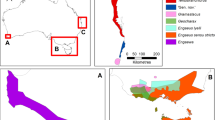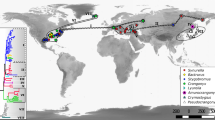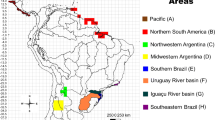Abstract
The spinicaudatan clam shrimp is a group of branchiopod crustaceans that has existed as far back as the Devonian and well-preserved fossils are known. Evidence of monophyly exists for only one family (Limnadiidae), which has a worldwide distribution and morphological conservatism. The evolutionary relationships among genera and diversification mechanisms are not deeply resolved as well as origin of the genus Eulimnadia. To address these issues, we constructed phylogenies of limnadiid clam shrimp, with both Bayesian inference and maximum likelihood methods to infer limnadiid evolutionary relationships. We then performed dated phylogenies using a relaxed clock of the Spinicaudata using fossil calibrations. Divergence date estimates show a perfect match with the break up of the Pangaea that could explain current limnadiid distributions; however the genus Eulimnadia apparently diverged 30 Ma ago. Eulimnadia phylogeography suggests an American origin and ecological patterns were analyzed to propose hypotheses on its origin and spread. This genus also shows a strong dispersive capacity, which could be explained by its reproduction modalities (androdioecy). This study and this first phylogeny with fossil calibration date the current distribution of Spinicaudata and reveal congruence with continental drift, except for Eulimnadia.



Similar content being viewed by others
References
Astrop, T. I. & T. A. Hegna, 2015. Phylogenetic relationships between living and fossil spinicaudatan taxa (branchiopoda Spinicaudata): reconsidering the evidence. Journal of Crustacean Biology 35: 1–16.
Belk, D., 1972. The biology and ecology of Eulimnadia antlei Mackin (Conchostraca). The Southwestern Naturalist 16: 297–305.
Benvenuto, C. & S. C. Weeks, 2011. Mate guarding behavior in clam shrimp: the influence of mating system on intersexual conflict. Behavioral Ecology and Sociobiology 65: 1899–1907.
Berry, E. W., 1926. Description and notes on the life history of a new species of Eulimnadia. American Journal of Science 11: 429–433.
Bishop, J. A., 1968. Aspects of the post-larval life history of Limnadia stanleyana King (Crustacea: Conchostraca). Australian Journal of Zoology 16: 885–895.
Bouckaert, R., J. Heled, D. Kühnert, T. Vaughan, C.-H. Wu, D. Xie, M. A. Suchard, A. Rambaut & A. J. Drummond, 2014. BEAST 2: a software platform for Bayesian evolutionary analysis. PLoS Computational Biology 10: e1003537.
Brendonck, L., A. Thiery & A. Coomans, 1990. Taxonomy and biogeography of the Galapagos branchiopod fauna (Anostraca, Notostraca, Spinicaudata). Journal of crustacean biology 10: 676–694.
Brendonck, L., Rogers, D. C., Olesen, J., S. C. Weeks & W. R. Hoeh, 2008. Global diversity of large branchiopods (Crustacea: Branchiopoda) in freshwater. In Freshwater Animal Diversity Assessment. Springer, New York: 167–176
Castresana, J., 2000. Selection of conserved blocks from multiple alignments for their use in phylogenetic analysis. Molecular Biology and Evolution 17: 540–552.
Chen, P., 1975. Tertiary conchostraca from China. Scientia Sinica 6: 618-630.
Cohen, K. M., S. C. Finney, P. L. Gibbard & J. X. Fan, 2013. The ICS International Chronostratigraphic Chart, International Commission on stratigraphy.
Darriba, D., G. L. Taboada, R. Doallo & D. Posada, 2012. jModelTest 2: more models, new heuristics and parallel computing. Nature Methods 9: 772.
De Meester, L., A. Gómez, B. Okamura & K. Schwenk, 2002. The monopolization hypothesis and the dispersal-gene flow paradox in aquatic organisms. Acta Oecologica 23: 121–135.
Dereeper, A., V. Guignon, G. Blanc, S. Audic, S. Buffet, F. Chevenet, J. F. Dufayard, S. Guindon, V. Lefort, M. Lescot, J. M. Claverie & O. Gascuel, 2008. Phylogeny.fr: robust phylogenetic analysis for the non-specialist. Nucleic Acids Research 36(Web Server issue): W465–W469.
Drummond, A. J., S. Y. Ho, M. J. Phillips & A. Rambaut, 2006. Relaxed phylogenetics and dating with confidence. PLoS Biology 4: e88.
Edgar, R. C., 2004. MUSCLE: multiple sequence alignment with high accuracy and high throughput. Nucleic Acids Research 32: 1792–1797.
Fayers, S. R. & N. H. Trewin, 2002. A new crustacean from the early Devonian Rhynie chert Aberdeenshire, Scotland. Transactions of the Royal Society of Edinburgh: Earth Sciences 93: 355–382.
Graham, T. B. & D. Wirth, 2008. Dispersal of large branchiopod cysts: potential movement by wind from potholes on the Colorado Plateau. Hydrobiologia 600: 17–27.
Giribet, G., S. Richter, G. D. Edgecombe & C. Wheeler, 2005. The position of crustaceans within Arthropoda: evidence from nine molecular loci and morphology. Crustacea and Arthropod Relationships 16: 307.
Gueriau, P., N. Rabet, G. Clément, L. Lagebro, J. Vannier, D. E. Briggs, S. Charbonnier, S. Olive & O. Béthoux, 2016. A 365-million-year-old freshwater community reveals morphological and ecological stasis in Branchiopod Crustaceans. Current Biology. doi:10.1016/j.cub.2015.12.039.
Guérin, F. E., 1837. Note monographique sur le genre limnadie, et description d’une espèce nouvelle de ce genre. Magasin de Zoologie Classe 7: 1–7.
Guindon, S. & O. Gascuel, 2003. A simple, fast, and accurate algorithm to estimate large phylogenies by maximum likelihood. Systematic Biology 52: 696–704.
Hall, T. A., 1999. BioEdit: a user-friendly biological sequence alignment editor and analysis program for Windows 95/98/NT. Nucleic Acids Symposium 41: 95–98.
Heled, J. & A. J. Drummond, 2012. Calibrated tree priors for relaxed phylogenetics and divergence time estimation. Systematic Biology 61: 138–149.
Hoeh, W. R., N. D. Smallwood, D. M. Senyo, E. G. Chapman & S. C. Weeks, 2006. Evaluating the monophyly of Eulimnadia and the Limnadiinae (Branchiopoda: Spinicaudata) using DNA sequences. Journal of Crustacean Biology 26: 182–192.
Kearse, M., R. Moir, A. Wilson, S. Stones-Havas, M. Cheung, S. Sturrock, S. Buxton, A. Cooper, S. Markowitz, C. Duran, T. Thierer, B. Ashton, P. Mentjies & A. Drummond, 2012. Geneious Basic: an integrated and extendable desktop software platform for the organization and analysis of sequence data. Bioinformatics 28: 1647–1649.
Korn, M., N. Rabet, H. V. Ghate, F. Marrone & A. K. Hundsdoerfer, 2013. Molecular phylogeny of the Notostraca. Molecular Phylogenetics and Evolution 69: 1159–1171.
Lagebro, L., P. Gueriau, T. A. Hegna, N. Rabet, A. D. Butler & G. E. Budd, 2015. The oldest notostracan (Upper Devonian Strud locality, Belgium). Palaeontology 58: 497–509.
MacKay, S. E. & D. D. Williams, 2011. Invertebrate colonization of the surface and deep groundwaters of a small oceanic island (Barbados, West Indies). Tropical Zoology 24: 1–48.
Mathias, P., 1936. A propos de la dissémination des Crustacés Phyllopodes. Compte Rendu de l’Association Française pour l’Avancement des Sciences 60: 335–337.
McKenzie, K. G., 1971. Entomostraca of Aldabra, with special reference to the Genus Heterocybris (Crustacea, Ostracoda). Philosophical Transactions of The Royal Society B 260: 257–297.
Mathers, T. C., R. L. Hammond, R. A. Jenner, B. Hänfling & A. Gómez, 2013. Multiple global radiations in tadpole shrimps challenge the concept of ‘living fossils’. PeerJ 1: e62.
Miller, M. A., W. Pfeiiffer & T. Schwartz, 2010 Creating the CIPRES Science Gateway for inference of large phylogenetic trees. In Proceedings of the Gateway Computing Environments Workshop (GCE), 14 Nov 2010, New Orleans, LA: 1–8.
Nourisson, M. & P. Aguesse, 1961. Cycle annuel des Phyllopodes d’une mare temporaire de Camargue. Bulletin de la Société Zoologique de France 86: 754–762.
Novojilov, N. I., 1970. Vymershie limnadioidei (Conchostraca-Limnadioidea). Nauka, Moscow.
Olesen, J., 2009. Phylogeny of Branchiopoda (Crustacea) – character evolution and contribution of uniquely preserved fossils. Arthropod Systematics & Phylogeny 67: 3–39.
Rabet, N., D. Montero & S. Lacau, 2014. The effects of soils and soil stay on the egg morphology of Neotropical Eulimnadia (Branchiopoda: Limnadiidae). Journal of Limnology 73: 17–26.
Reed, S. K., R. J. Duff & S. C. Weeks, 2015. A systematic study of the genus Eulimnadia. Journal of Crustacean Biology 35: 379–391.
Remigio, E. A. & P. D. Hebert, 2000. Affinities among anostracan (Crustacea: Branchiopoda) families inferred from phylogenetic analyses of multiple gene sequences. Molecular Phylogenetics and Evolution 17: 117–128.
Richter, S., J. Olesen & W. C. Wheeler, 2007. Phylogeny of Branchiopoda (Crustacea) based on a combined analysis of morphological data and six molecular loci. Cladistics 23: 301–336.
Richters, F., 1882. Limnadia Garretti nov. sp. Abhandlungen der Senckenbergischen Naturforschenden Gesellschaft 12: 432–433.
Roessler, E. W., 1995. Review of Colombian conchostraca (Crustacea) – morphotaxonomic aspects. Studies on Large Branchiopod biology and aquaculture II. Springer, New York: 253–262.
Rogers, D. C., 2014. Larger hatching fractions in avian dispersed anostracan eggs (branchiopoda). Journal of Crustacean Biology 34: 135–143.
Rogers, D. C., 2015. A conceptual model for anostracan biogeography. Journal of Crustacean Biology 35: 686–699.
Rogers, D. C., N. Rabet & S. C. Weeks, 2012. Revision of the extant genera of Limnadiidae (Branchiopoda: Spinicaudata). Journal of Crustacean Biology 32: 827–842.
Rogers, D. C., N. Rabet & S. C. Weeks, 2016. Gondwanalimnadia (branchiopoda: spinicaudata) replacement name for Afrolimnadia Rogers, Rabet and Weeks, 2012 (limnadiidae), junior homonym of Afrolimnadia Tasch, 1987 (Lioestheriidae). Journal of Crustacean Biology 36: 105.
Ronquist, F. & J. P. Huelsenbeck, 2003. MrBayes 3: Bayesian phylogenetic inference under mixed models. Bioinformatics 19: 1572–1574.
Sassaman, C. & S. C. Weeks, 1993. The genetic mechanism of sex determination in the conchostracan shrimp Eulimnadia texana. American Naturalist 141: 314–328.
Scotese, C.R., 2001. Atlas of earth history: University of Texas at Arlington. Department of Geology. PALEOMAP Project
Schwentner, M., B. V. Timms, R. Bastrop & S. Richter, 2009. Phylogeny of Spinicaudata (Branchiopoda, Crustacea) based on three molecular markers - An Australian origin for Limnadopsis. Molecular Phylogenetics and Evolution 53: 716–725.
Schwentner, M., B. V. Timms & S. Richter, 2012. Flying with the birds? Recent large-area dispersal of four Australian Limnadopsis species (Crustacea: Branchiopoda: Spinicaudata). Ecology and Evolution 2: 1605–1626.
Smith, D. G. & C. D. Little, 2003. New records of and observations on Branchiopoda of St. John, United States Virgin Islands. Crustaceana 76: 631–636.
Sonnenberg, R., A. W. Nolte & D. Tautz, 2007. An evaluation of the LSU rDNA D1-D2 sequences for their use in species identification. Frontiers in Zoology 4: 6.
Stoddart, D. R. & C. A. Wright, 1967. Ecology of Aldabra Atoll. Nature 213: 1174–1177.
Tasch, P., 1967. Fossil clam shrimp distribution and its significance for the theory of continental drift. Transactions of the Kansas Academy of Science 70: 151–163.
Tasch, P., 1987. Fossil Conchostraca of the Southern Hemisphere and Continental Drift: paleontology, biostratigraphy, and dispersal. Geological Society of America Memoir 165: 1–290.
Telford, M. J., A. E. Lockyer, C. Cartwright-Finch & D. T. J. Littlewood, 2003. Combined large and small subunit ribosomal RNA phylogenies support a basal position of the acoelomorph flatworms. Proceedings of the Royal Society of London B: Biological Sciences 270: 1077–1083.
Timms, B. V. & M. Schwentner, 2012. A new genus and species of large Limnadiid clam shrimp from Australia (Spinicaudata: Limnadiidae). Journal of Crustacean Biology 32: 981–990.
Vanschoenwinkel, B., S. Gielen, M. Seaman & L. Brendonck, 2008. Any way the wind blows – frequent wind dispersal drives species sorting in ephemeral aquatic communities. Oikos 117: 125–134.
Vidrine, M. F., S. L. Sissom & R. E. McLaughlin, 1987. Eulimnadia texana Packard (Conchostraca: Limnadiidae) in rice fields in southwestern Louisiana. The Southwestern Naturalist 32: 1–4.
Weeks, S. C., V. Marcus & S. Alvarez, 1997. Notes on the life history of the clam shrimp, Eulimnadia texana. Hydrobiologia 359: 191–197.
Weeks, S. C., T. F. Sanderson, S. K. Reed, M. Zofkova, B. Knott, U. Balaraman, G. Pereira, D. M. Senyo & W. R. Hoeh, 2006. Ancient androdioecy in the freshwater crustacean Eulimnadia. Proceedings of the Royal Society B 273: 725–734.
Weeks, S. C., E. G. Chapman, D. C. Rogers, D. M. Senyo & W. R. Hoeh, 2009. Evolutionary transitions among dioecy, androdioecy and hermaphroditism in limnadiid clam shrimp (Branchiopoda: Spinicaudata). Journal of evolutionary Biology 22: 1781–1799.
Zhang, W. T., P. J. Chen & Y. B. Shen, 1976. Chinese Fossils of all Groups: Fossil Conchostraca of China. Science Press, Peking.
Zinn, D. J. & R. W. Dexter, 1962. Reappearance of Eulimnadia agassizii with notes on its biology and life history. Science 137: 676–677.
Acknowledgments
We are very grateful to Clara Lord for stimulating discussions and English corrections. We would like to thank Sébastien Lacau and Marc Pignal for soil collection in Brazil and Michaël Manuel for collecting the new Limnadiid from Bolivia. We also thank the UMS 2700 and the Service de Systématique Moléculaire (MNHN, Paris) for support in lab work.
Author information
Authors and Affiliations
Corresponding author
Additional information
Handling editor: Diego Fontaneto
Electronic supplementary material
Below is the link to the electronic supplementary material.
Rights and permissions
About this article
Cite this article
Bellec, L., Rabet, N. Dating of the Limnadiidae family suggests an American origin of Eulimnadia . Hydrobiologia 773, 149–161 (2016). https://doi.org/10.1007/s10750-016-2694-x
Received:
Revised:
Accepted:
Published:
Issue Date:
DOI: https://doi.org/10.1007/s10750-016-2694-x




